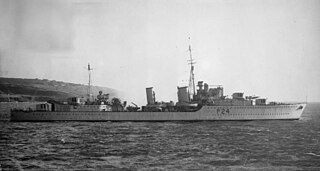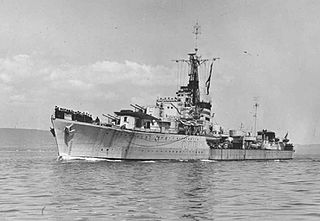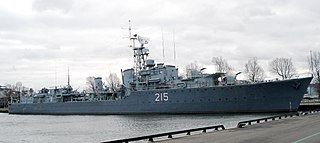
HMS Havock was an H-class destroyer built for the British Royal Navy in the mid-1930s. During the Spanish Civil War of 1936–1939, the ship enforced the arms blockade imposed by Britain and France on both sides as part of the Mediterranean Fleet. During the first few months of the Second World War, Havock searched for German commerce raiders in the Atlantic Ocean and participated in the First Battle of Narvik during the Norwegian Campaign of April–June 1940 before she was transferred back to the Mediterranean Fleet in May where she escorted a number of convoys to Malta. The ship took part in the Battle of Cape Spada in July 1940, the Battle of Cape Matapan in March 1941 and the evacuation of Greece in April 1941. She was damaged during the Battle of Crete the following month, but participated in the Syria–Lebanon Campaign in June.

HMS Maori was a Tribal-class destroyer named after the indigenous Māori people of New Zealand. She served with the United Kingdom Mediterranean Fleet during World War II until she was bombed and sunk by German aircraft while at Malta in 1942. Her wreck was later raised and scuttled outside the Grand Harbour. The wreck is now a dive site.

HMS Cossack was a Tribal-class destroyer named after the Cossack people of the Eurasian steppe. She became famous for the boarding of the German supply ship Altmark in Norwegian waters, and the associated rescue of sailors originally captured by the Admiral Graf Spee. She was torpedoed by the German submarine U-563 on 23 October 1941, and sank four days later.

HMS Jervis, was a J-class destroyer built for the Royal Navy in the late 1930s. She was named after Admiral John Jervis (1735–1823). She was laid down by R. and W. Hawthorn, Leslie and Company, Limited, at Hebburn-on-Tyne on 26 August 1937. The ship was launched on 9 September 1938 and commissioned on 8 May 1939, four months before the start of the Second World War.

HMS Afridi was one of 16 Tribal-class destroyers built for the Royal Navy shortly before the beginning of Second World War in 1939. Completed in 1938 the ship was initially assigned to the Mediterranean Fleet where she served as a flotilla leader. Afridi was briefly involved enforcing the arms blockade on the combatants in the Spanish Civil War. The ship returned home shortly after the start of the Second World War and was assigned convoy escort duties. She played an active role in the Norwegian Campaign of April–May 1940, escorting convoys to and from Norway. Afridi was sunk by German dive bombers on 3 May as she was escorting the evacuation convoy after the failure of the Namsos Campaign.

HMS Gurkha was a Tribal-class destroyer that saw active service in the Norway Campaign in 1940, where she was sunk.

The Tribal class, or Afridi class, was a class of destroyers built for the Royal Navy, Royal Canadian Navy and Royal Australian Navy that saw service in World War II. Originally conceived during design studies for a light fleet cruiser, the Tribals evolved into fast, powerful destroyers, with greater emphasis on guns over torpedoes than previous destroyers, in response to new designs by Japan, Italy, and Germany. The Tribals were well admired by their crews and the public when they were in service due to their power, often becoming symbols of prestige while in service.

HMS Zulu was a Tribal-class destroyer of the Royal Navy and the second ship to bear the name. Built in Glasgow by Alexander Stephen and Sons, her keel was laid down on 10 August 1936, she was launched on 23 September 1937 and commissioned on 7 September 1938.

HMS Eskimo was a Tribal-class destroyer, Eskimo served throughout the Second World War, seeing action in Norway, the Mediterranean, the English Channel and in Burma. After the war Eskimo was used as an accommodation and headquarters ship, finally being used as a practice target before being scrapped in 1949.

HMS Mohawk was one of 16 Tribal-class destroyers built for the Royal Navy shortly before the beginning of Second World War in 1939. Completed in 1938 the ship was initially assigned to the Mediterranean Fleet. She was briefly involved enforcing the arms blockade on the combatants in the Spanish Civil War in early 1939. Mohawk returned home shortly after the start of the Second World War and was assigned convoy escort duties, during which she was damaged by German bombers. She played an active role in the Norwegian Campaign of April–May 1940, escorting convoys to and from Norway.

HMS Greyhound was a G-class destroyer built for the Royal Navy in the 1930s. Greyhound participated in the Norwegian Campaign in April 1940, the Dunkirk evacuation in May and the Battle of Dakar in September before being transferred to the Mediterranean Fleet in November. The ship generally escorted the larger ships of the Mediterranean Fleet as they protected convoys against attacks from the Italian Fleet. She sank two Italian submarines while escorting convoys herself in early 1941. Greyhound was sunk by German Junkers Ju 87 Stuka dive bombers north-west of Crete on 22 May 1941 as she escorted the battleships of the Mediterranean Fleet attempting to intercept the German sea-borne invasion forces destined for Crete.

HMS Sikh was a Tribal-class destroyer of the British Royal Navy. The ship entered service in 1938 and served during the Second World War, participating in the sinking of Bismarck and the Battle of Cape Bon. In 1942, while participating in a commando raid, Sikh was sunk by a combination of shore artillery, anti-aircraft guns and aerial bombs.

HMS Ashanti was a Tribal-class destroyer of the Royal Navy. Following the style of her sister ships she was named for an ethnic group, in this case the Ashanti people of the Gold Coast in West Africa. She served in the Second World War and was broken up in 1949. She was the first of two Royal Navy ships to bear the name Ashanti.

The J, K and N class consisted of 24 destroyers built for the Royal Navy beginning in 1938. They were a return to a smaller vessel, with a heavier torpedo armament, after the Tribal class that emphasised guns over torpedoes. The ships were built in three flotillas or groups, each consisting of eight ships with names beginning with "J", "K" and "N". The flag superior of the pennant numbers changed from "F" to "G" in 1940.

HMS Punjabi was a Tribal-class destroyer of the Royal Navy that saw service in the Second World War, being sunk in a collision with the battleship King George V. She has been the only ship of the Royal Navy to bear the name "Punjabi" which, in common with the other ships of the Tribal class, was named after various ethnic groups of the world, mainly those of the British Empire.

HMS Matabele was a Tribal-class destroyer of the Royal Navy that saw service in World War II, being sunk by a U-boat on 17 January 1942. She has been the only ship of the Royal Navy to bear the name Matabele, which in common with the other ships of the Tribal class, was named after an ethnic group of the British Empire. In this case, this was the Anglicisation of the Ndebele people of Zimbabwe.

HMS Mashona was one of 16 Tribal-class destroyers built for the Royal Navy shortly before the beginning of Second World War in 1939. Completed in that year, she was assigned to the Home Fleet. During the first year of the war, the ship was on convoy escort duties. Mashona played an active role in the Norwegian Campaign of April–May 1940, escorting convoys to and from Norway. The ship helped to briefly seize four Swedish warships en route from Italy to Sweden in June 1940 and resumed her role of convoy escort after their release in July. She accidentally collided with one of her sister ships in early 1941 and spent several months under repair.

HMS Tartar was a Tribal-class destroyer of the Royal Navy that saw service in most of the naval theatres of World War II. She had an eventful career, eventually receiving the nickname 'Lucky Tartar' due to her numerous escapes from dangerous situations. She was one of only four from the sixteen Royal Navy-operated Tribal-class destroyers to survive the war.

HMS Somali was a Tribal-class destroyer of the British Royal Navy that saw service in World War II. She was launched in 1937, captured the first prize of World War II and served in Home and Mediterranean waters. She was torpedoed on 20 September 1942 in the Arctic and foundered five days later while under tow.

HMS Bedouin was a Tribal-class destroyer of the British Royal Navy that saw service in World War II.





















